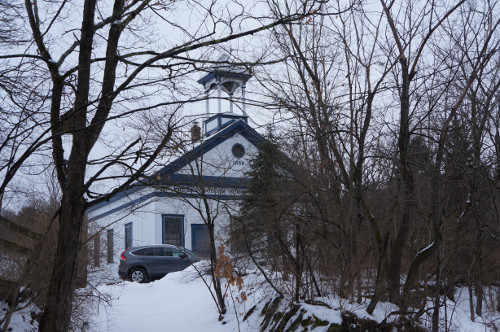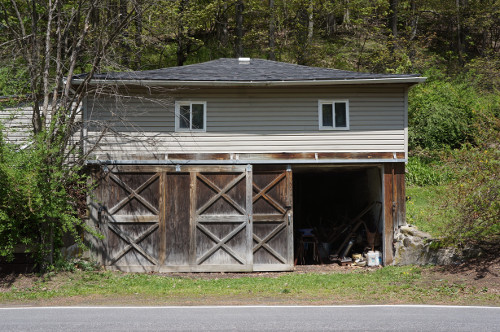G. Brian Karas on The Village Blacksmith
 May 19th, 2020 by jules
May 19th, 2020 by jules
And hear the bellows roar.
And catch the burning sparks that fly
Like chaff from a threshing-floor.”
(Click spread to enlarge)
Illustrator G. Brian Karas visits today to talk a bit about his newest picture book, an adaptation of a poem originally written in 1840 by Henry Wadsworth Longfellow. The Village Blacksmith (Candlewick, April 2020) tells the story of a strong but humble village smithy, “his brow … wet with honest sweat.” He works, building a fence for a neighbor; worships at church; rests; and works again, “[w]eek out, week in, from morn till night.” Karas brings his world to vivid life with his soft mixed media illustrations, and he beautifully depicts the light and shadows of the smithy’s work (particularly its glowing embers and shining sparks), while we follow him through his days at the “flaming forge” and beyond, “[t]oiling — rejoicing — sorrowing — / Onward through life he goes.”
The book’s backmatter includes tools of a blacksmith’s trade and a brief history of blacksmiths, and Longfellow’s poem in its entirety is printed in the back as well.
Brian is here to share some of the personal backstory behind this warm and intimate book, which he places in a contemporary setting, as well as share some images and some final art. I thank him for sharing.
Brian: Illustrating Longfellow’s poem, written 180 years ago, was surprisingly relevant to me. That allowed me to bring much of my personal life to the story.
At the time I started working on this book, I had recently purchased a 150-year old home in a small village — technically, a hamlet, an administrative division in New York State. Hamlets are smaller than villages.


Back in the day, Smokey Hollow, as it was then known, was a self-sufficient community that I modeled the village in the book after. The red building across the street from me was owned by the man who built my house and was the “trading post” for the local tradespeople in the hamlet.

Though there is no spreading chestnut tree overhead [as in the poem], my house was built with hand hewn chestnut beams. Who knows, maybe the builder chopped down his own spreading chestnut tree!

What made this book most meaningful to me, though, is that my son is an artist, and his medium of choice is metal. Blacksmithing is one of the skills he uses to create his work. He was always fascinated with blacksmithing and built his own forge at a young age.

This is his workshop and smithy today — not red, as in the book (but possibly red when it was built to match the trading post?).


The village smithy stands …”
(Click spread to enlarge)
Blacksmiths keep their smithies dark so that they can tell by the color of the heated metal when it’s hot enough to shape.
Here is an example of my son’s work:

My iron gate (still waiting to be repaired — LOL):

Here is a bit more from the book:



THE VILLAGE BLACKSMITH. “The Village Blacksmith” by Henry Wadsworth Longfellow from The Knickerbocker or New York Monthly Magazine vol. XVI. New York; 1840. Illustrations copyright © 2020 by G. Brian Karas and reproduced by permission of the publisher, Candlewick Press, Somerville, MA. All other images here reproduced by permission of G. Brian Karas.


Thank you for featuring another beautiful book from a favorite children’s book creator. This one looks special.